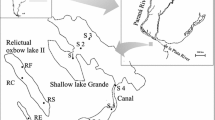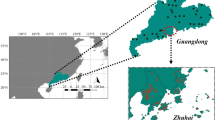Abstract
Phytoplankton diversity was studied in two North German lakes of comparable nutrient chemistry but different exposure to winds. In both lakes, phytoplankton was primarily N-limited but diatoms were Si-limited. Plußsee had a very constant mixing depth during summer, while week-to-week changes of several meters were quite common in the more exposed Behler See. In Plußsee, phytoplankton biomass during summer came closer to the carrying capacity as defined by the available total N. In Plußsee there was a marked decline of diversity during the summer maximum of biomass, while this decline was less pronounced in Behler See. It is concluded that disturbances which prevented phytoplankton from reaching the carrying capacity also maintained a high level of diversity. A negative response of diversity to undisturbed conditions became apparent, after phytoplankton biomass had exceeded about 5% of the carrying capacity.
Similar content being viewed by others
References
Armstrong, R. A. & R. McGehee, 1976. Coexistence of species competing for shared resources. Theor. Pop. Biol. 9: 317–328.
Chatfield, C., 1984. The analysis of time series. 3rd edn. Chapman & Hall, London.
Connell, J., 1978. Diversity in tropical rain forests and coral reefs. Science 199: 1304–1310.
Droop, M. R., 1973. Some thoughts on nutrient limitation in algae. J. Phycol. 9: 264–272.
Ebenhöh, W., 1988. Coexistence of an unlimited number of algal species in a model system. Theor. Pop. Biol. 34: 130–144.
Gaedeke, A. & U. Sommer, 1986. The influence of the frequency of periodic disturbances. Oecologia 71: 98–102.
Goldman, J. C., J. J. McCarthy & D. G. Peavey, 1979. Growth rate influence on the chemical composition of phytoplankton in oceanic waters. Nature 279: 210–215.
Grenney, W. J., 1973. A theoretical approach to interspecific competition in the phytoplankton community. Am. Nat. 107: 405–425.
Grover, J. P., 1988. Dynamics of competition in a variable environment. Ecology 69: 408–417.
Grover, J. P., 1989. Effects of Si:P supply ratio, supply variability, and selective grazing in the plankton: An experiment with a natural algal and protistan assemblage. Limnol. Oceanogr. 34: 349–367.
Grover, J. P., 1990. Resource competition in a variable environment: Phytoplankton growing according to Monod's model. Am. Nat. 136: 772–789.
Grover, J. P., 1991. Non-steady state dynamics of algal population growth: experiments with two chlorophytes. J. Phycol. 27: 70–79.
Hutchinson, G. E., 1961. The paradox of the plankton. Am. Nat. 95: 137–145.
Lampert, W., 1988. The relationship between zooplankton biomass and grazing: A review. Limnologica 19: 11–20.
Levins, R., 1979. Coexistence in a variable environment. Am. Nat. 114: 765–783.
Petersen, R., 1975. The paradox of the plankton: An equilibrium hypothesis. Am. Nat. 109: 35–49.
Reynolds, C. S., 1980. Phytoplankton assemblages and their periodicity in stratifying lake systems. Holarctic Ecol. 3: 141–159.
Reynolds, C. S., 1984. Phytoplankton periodicity; the interaction of form, function and environmental variability. Freshwat. Biol. 14: 111–142.
Reynolds, C. S., 1988. Functional morphology and the adaptive strategies of freshwater phytoplankton. In C. D. Sandgren (ed.), Growth and Reproductive strategies of freshwater phytoplankton. Cambridge Univ. Press. 388–433.
Reynolds, C. S., 1981. Lake communities: An approach to their management for conservation: In F. Spellerberg, F. B. Goldsmith & M. G. Morris (eds), The specific management of temperate communities for conservation. Blackwell, Oxford, pp. 199–225.
Richerson, P., R. Armstrong & C. R. Goldman, 1970. Contemporaneous disequilibrium, a new hypothesis to explain the ‘paradox of plankton’. Proc. nat. Acad. Sci. 67: 1710–1714.
Robinson, J. D. & C. D. Sandgren, 1983. The effect of temporal environmental heterogeneity on community structure: a replicated experimental study. Oecologia 57: 98–102.
Rocha, O. & A. Duncan, 1985. The relationship between cell carbon and cell volume in freshwater algal species used in zooplankton studies. J. Plankton Res. 7: 279–294.
Sommer, U., 1983. Nutrient competition between phytoplankton in multispecies chemostat experiments. Arch. Hydrobiol. 96: 399–416.
Sommer, U., 1984. The paradox of the plankton: Fluctuations of phosphorus availability maintain diversity in flow-through cultures. Limnol. Oceanogr. 29: 633–636.
Sommer, U., 1985. Comparison between stedy state and non-steady state competition: Experiments with natural phytoplankton. Limnol Oceanogr. 30: 335–346.
Sommer, U., 1989. The role of competition for resources in phytoplankton succession. In: U. Sommer (ed.), Plankton ecology: succession in plankton communities. Springer, Berlin, 57–106.
Sommer, U. 1991a. The application of the Droop-model of nutrient limitation to natural phytoplankton. Verh. int. Ver. Limnol. 24: 791–794.
Sommer, U. 1991b. A comparison of the Droop-model and the Monod-model of nutrient limited growth applied to natural populations of phytoplankton. Funct. Ecol. 5: 535–544.
Sommer, U., Z. M. Gliwicz, W. Lampert & A. Duncan, 1986. The PEG-model of seasonal succession of planktonic events in fresh waters. Arch. Hydrobiol. 106: 433–471.
Tilman, D., 1977. Resource competition between planktonic algae: an experimental and theoretical approach. Ecology 58: 338–348.
Tilman, D., 1982. Resource competition and community structure. Princeton Univ. Press, Princeton.
Turpin, D. H. & P. J. Harrison, 1980. Cell size manipulation in natural marine planktonic diatom communities. Can. J. Fish. aquat. Sci. 37: 1193–1195.
Washington, H. G., 1984. Diversity, biotic and similarity indices. Wat. Res. 18: 653–694.
Author information
Authors and Affiliations
Rights and permissions
About this article
Cite this article
Sommer, U. Disturbance-diversity relationships in two lakes of similar nutrient chemistry but contrasting disturbance regimes. Hydrobiologia 249, 59–65 (1993). https://doi.org/10.1007/BF00008843
Issue Date:
DOI: https://doi.org/10.1007/BF00008843




